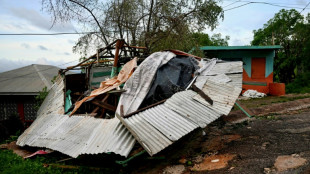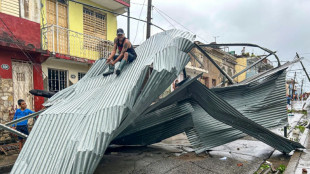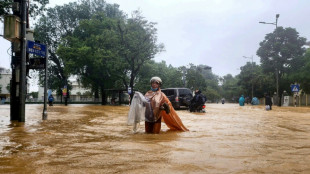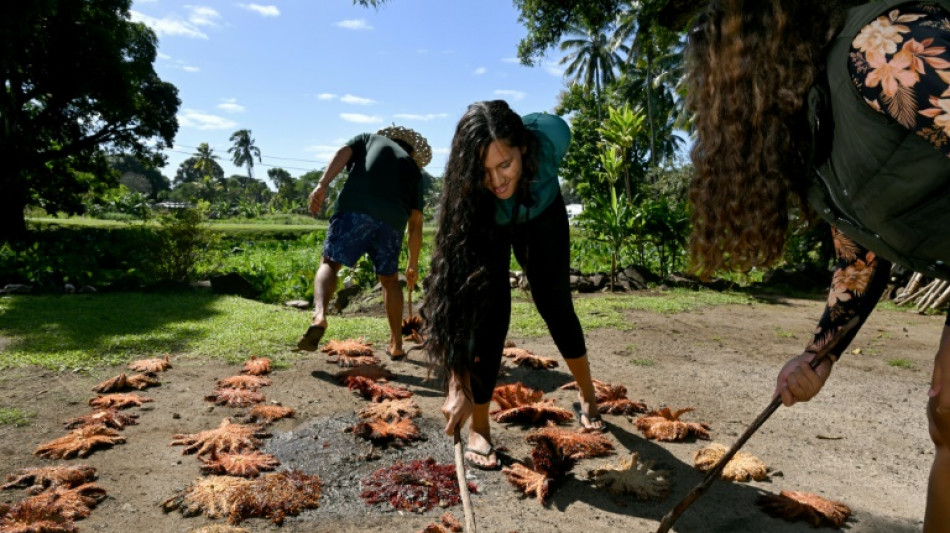
-
 Asia markets fluctuate as investors mull Trump-Xi talks
Asia markets fluctuate as investors mull Trump-Xi talks
-
Trump, Xi ease fight on tariffs, rare earths

-
 Volkswagen posts 1-billion-euro loss on tariffs, Porsche woes
Volkswagen posts 1-billion-euro loss on tariffs, Porsche woes
-
'Fight fire with fire': California mulls skewing electoral map

-
 Fentanyl, beans and Ukraine: Trump hails 'success' in talks with Xi
Fentanyl, beans and Ukraine: Trump hails 'success' in talks with Xi
-
'Nowhere to sleep': Melissa upends life for Jamaicans
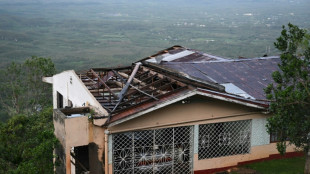
-
 Irish octogenarian enjoys new lease on life making harps
Irish octogenarian enjoys new lease on life making harps
-
Tanzania blackout after election chaos, deaths feared

-
 G7 meets on countering China's critical mineral dominance
G7 meets on countering China's critical mineral dominance
-
Trump hails tariff, rare earth deal with Xi

-
 Court rules against K-pop group NewJeans in label dispute
Court rules against K-pop group NewJeans in label dispute
-
India's Iyer says 'getting better by the day' after lacerated spleen

-
 Yesavage fairytale carries Blue Jays to World Series brink
Yesavage fairytale carries Blue Jays to World Series brink
-
Bank of Japan keeps interest rates unchanged

-
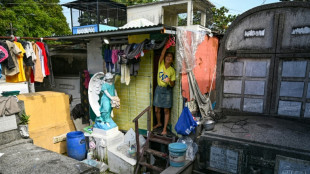 Impoverished Filipinos forge a life among the tombstones
Impoverished Filipinos forge a life among the tombstones
-
Jokic posts fourth straight triple-double as Nuggets rout Pelicans

-
 UN calls for end to Sudan siege after mass hospital killings
UN calls for end to Sudan siege after mass hospital killings
-
Teenage Australian cricketer dies after being hit by ball

-
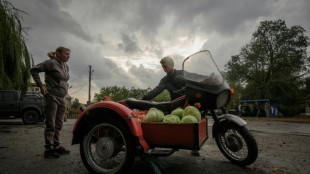 As Russia advances on Kupiansk, Ukrainians fear second occupation
As Russia advances on Kupiansk, Ukrainians fear second occupation
-
Trade truce in balance as Trump meets 'tough negotiator' Xi

-
 China to send youngest astronaut, mice on space mission this week
China to send youngest astronaut, mice on space mission this week
-
Yesavage gem carries Blue Jays to brink of World Series as Dodgers downed

-
 With inflation under control, ECB to hold rates steady again
With inflation under control, ECB to hold rates steady again
-
Asia stocks muted with all eyes on Trump-Xi meeting

-
 Personal tipping points: Four people share their climate journeys
Personal tipping points: Four people share their climate journeys
-
Moto3 rider Dettwiler 'no longer critical' after crash: family

-
 US economy in the dark as government shutdown cuts off crucial data
US economy in the dark as government shutdown cuts off crucial data
-
Trump orders nuclear testing resumption ahead of Xi talks

-
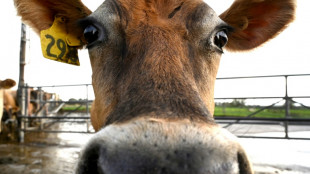 'Utter madness': NZ farmers agree dairy sale to French group
'Utter madness': NZ farmers agree dairy sale to French group
-
Samsung posts 32% profit rise on-year in third quarter

-
 30 years after cliffhanger vote, Quebec separatists voice hope for independence
30 years after cliffhanger vote, Quebec separatists voice hope for independence
-
Taxes, labor laws, pensions: what Milei wants to do next

-
 South Sudan's blind football team dreams of Paralympic glory
South Sudan's blind football team dreams of Paralympic glory
-
US says 4 killed in new strike on alleged Pacific drug boat

-
 What we do and don't know about Rio's deadly police raid
What we do and don't know about Rio's deadly police raid
-
'They slit my son's throat' says mother of teen killed in Rio police raid

-
 Arteta hails 'special' Dowman after 15-year-old makes historic Arsenal start
Arteta hails 'special' Dowman after 15-year-old makes historic Arsenal start
-
Google parent Alphabet posts first $100 bn quarter as AI fuels growth

-
 Underwater 'human habitat' aims to allow researchers to make weeklong dives
Underwater 'human habitat' aims to allow researchers to make weeklong dives
-
Maresca slams Delap for 'stupid' red card in Chelsea win at Wolves

-
 'Non-interventionist' Trump flexes muscles in Latin America
'Non-interventionist' Trump flexes muscles in Latin America
-
Slot defends League Cup selection despite not meeting 'Liverpool standards'

-
 'Poor' PSG retain Ligue 1 lead despite stalemate and Doue injury
'Poor' PSG retain Ligue 1 lead despite stalemate and Doue injury
-
Liverpool crisis mounts after League Cup exit against Palace

-
 Kane scores twice as Bayern set European wins record
Kane scores twice as Bayern set European wins record
-
Radio Free Asia suspends operations after Trump cuts and shutdown

-
 Meta shares sink as $16 bn US tax charge tanks profit
Meta shares sink as $16 bn US tax charge tanks profit
-
Dollar rises after Fed chair says December rate cut not a given

-
 Google parent Alphabet posts first $100 bn quarter as AI drives growth
Google parent Alphabet posts first $100 bn quarter as AI drives growth
-
Rob Jetten: ex-athlete setting the pace in Dutch politics


Cook Islands wages war on 'plague' of hungry starfish
Divers clutch wooden spears as they plunge beneath the waves, hunting hordes of hungry starfish destroying the coral reefs around the Cook Islands.
These makeshift tools are their best weapons in the war against crown-of-thorns starfish, a coral-munching species eating through tropical reefs already weakened by climate change.
The Cook Islands, a South Pacific nation of about 17,000 people, is in the grips of a years-long outbreak, says marine biologist Teina Rongo.
"It can completely kill off the entire reef, right around the island," said Rongo, who organises volunteers protecting the reefs fringing the isle of Rarotonga.
"I think there seems to be a Pacific-wide outbreak at the moment, because we're hearing other countries are facing similar challenges."
A single crown-of-thorns adult can eat more than 10 square metres (110 square feet) of reef each year, squeezing its stomach through its mouth to coat coral in digestive juices.
They pose a major threat to Australia's Great Barrier Reef, where scientists have developed robots that hunt down the prickly invertebrates and inject them with poison.
"At the moment, you basically kill them by injection," said researcher Sven Uthicke, from the Australian Institute of Marine Science.
"It could be vinegar, it could be lime juice or ox bile.
"Others are building chemical attraction traps. It's all very promising -- but it's in the development stage."
Rongo finds it quickest to pry the feasting starfish loose using a wooden stick cut from the dense timber of the Pacific Ironwood tree.
"Basically, we use a stick with a hook at the end," he said.
"We've made some modifications over time because we were getting pricked by these starfish. It's painful."
Named for their hundreds of venomous spikes, crown-of-thorns starfish have as many as 21 fleshy arms and can grow larger than a car tyre.
They are typically found in such low numbers that they are not considered a problem.
But sporadically populations explode in a feeding frenzy that rapidly strips the life from reefs.
- 'Plague proportions ' -
They spawn in "plague proportions", according to the Australian Institute of Marine Science, and are a major driver of coral loss.
From the Red Sea to the Pacific Ocean, crown-of-thorns outbreaks appear to be becoming both more frequent and more severe.
"Some argue that the crown-of-thorns has become chronic in the last few decades," said Rongo, talking about the reefs of the South Pacific.
Scientists suspect these outbreaks are triggered by a mix of factors, including nutrients leached into the sea from agriculture and fluctuations in natural predators.
But the damage they can cause is getting worse as reefs are weakened by climate change-fuelled coral bleaching and ocean acidification.
"This is why it's important for us to help the reef," says Rongo.
Scuba divers scour the Cook Islands' reefs for hard-to-spot starfish wedged into dimly lit crevices.
Once peeled off the coral, the starfish are pierced with a thick rope so they can be dragged back up to a waiting boat.
The day's haul is dumped into a plastic chest before the starfish are lugged ashore to be counted, measured and mulched for garden fertiliser.
They are known as "taramea" in Cook Islands Maori, which loosely translates to "spiky thing".
The volunteer divers working with Rongo and his environmental group Korero O Te Orau -- or Knowledge of the Land, Sky and Sea -- remove thousands of starfish every year.
Rongo is spurred by the devastation from the nation's last major infestation in the 1990s.
"I was part of that eradication effort.
"We were too late when we did decide to do something about it. It went on and ended up killing the reef."
J.Sauter--VB

